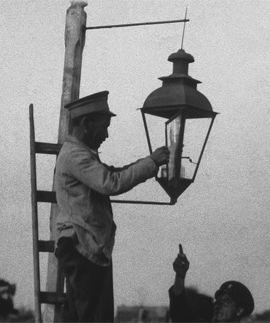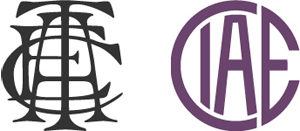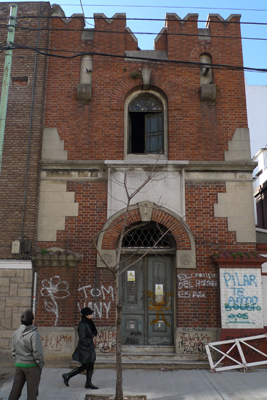[Some material for the following series of posts originally published as “unexpected eagles” on 14 Jul 2007, “more ciae goodness” on 30 Oct 2007, “superpower” on 29 Dec 2007, “inside the kavanagh 2” on 15 Mar 2008, “usina de la música” on 17 Jun 2008… the CIAE was obviously a recurring blog topic. This series is an amalgam & significant expansion of original content.]

Precedent
Argentina, like the rest of the world, began going electric at the end of the 1880’s. Edison’s improvement of the incandescent light bulb in 1879 generated not only massive interest in electricity as a cheaper energy source, but it also gave birth to several companies needed to supply such a capital- & equipment-heavy venture. During the same era, foreign investment was deemed vital to stable economic growth in Argentina which had rich agricultural potential but was far from developing its own industry. Interestingly, not everyone was convinced of the newest technology. Buenos Aires appeared, in fact, reluctant to switch to electricity —the honor of first city in South America with public electric lighting went to La Plata in 1881. In the meantime, a number of European companies tried to convince city officials in Buenos Aires to modernize the national capital.
The UK-based Compañía de Electricidad del Río de la Plata (CERP) was one of the first to install generators in Buenos Aires. English companies had previously developed natural gas networks in the city & seemed interested in expanding to provide electricity. But their initial output was limited & other companies soon jumped on the bandwagon. Via a branch of Deutsche Bank established in Buenos Aires in 1887, the German electric company Allgemeine Elektricitäts-Gesellschaft (AEG) obtained permission from the Buenos Aires government to provide the city with electricity. In 1898, the Compañía Alemana Transatlántica de Electricidad (CATE) —with dual headquarters in Berlin & Buenos Aires— bought all of the original electric companies to consolidate their service. In addition, the CATE signed a controversial non-competition contract in 1903 with the largest trolley company in Buenos Aires, the Compañía Anglo-Argentina de Tranvías. Anglo agreed to generate electricity necessary for their public transport service but would not provide electricity to other customers. It made sense at the time: both businesses required huge initial investments in both equipment & infrastructure. Their contract made it possible for them to work alongside each other & benefit from specialization.
Remember: Public utilities are often considered natural monopolies— due to economies of scale, a sole supplier usually offers greater efficiency & better prices.
After approximately a decade of service, the CATE negotiated a 50-year concession with the city of Buenos Aires. The contract never explicitly granted a legal monopoly to the CATE, but no other company could efficiently compete with them. Hence, their monopoly was a consequence of economics rather than an official agreement… an important point to understand when the CIAE formed five years later.

Foundation
Without the foresight of Juan Carosio, the CIAE would have never come into existence. An Italian immigrant, Carosio worked for the CERP before the German buyout & installed electrical networks in various Argentine provinces & in Paraguay. He considered the time perfect to start a new electrical company in Buenos Aires —demand was rising & no other provider was investing in new generators. Thinking big, Carosio’s plan also involved absorbing all of the smaller electrical companies which had recently come into existence to compete with the CATE. The city would benefit as well because increased competition typically lowers rates… but Carosio could not do it alone.
In the early 20th century, engineers were not only technical advisors but also company executives —the movers & shakers of industry. Carosio maintained business ties with large Italian equipment manufacturers like Pirelli & Franco Tosi from previous jobs. Carosio’s local connections also helped immensely: influential friends included members of the Banco de Italia y Río de la Plata as well as the Grupo Devoto & Narciso Ocampo. In summary, Carosio had the technical know-how plus overseas business connections & local friends to help foot the bill for a new electrical company.
All he needed was a little extra cash… available from a Swiss holding company and two Swiss banks. The Swiss aggressively expanded investment in Italy in the early 20th century, so naturally they became involved in Argentine business ventures. Italian immigrants brought their business interests & connections with them. No doubt porteños saw how much income CATE was going to generate & Carosio’s new venture was a way to cut into that big pie. The alliance of the oligarchy with foreign capital also seemed to be a good match.

The Compañía Italo-Argentina de Electricidad (CIAE) came into existence in 1912 with initial capital set at $2 million m/n (moneda nacional). Rapid purchase of all shares convinced Carosio to increase starting funds to $5 million m/n. After sales were complete, 46% of shares belonged to the Buenos Aires-based Italian immigrant elite, 24% was owned by Italian manufacturers, & Swiss investors claimed the remaining 30%. Many authors mistakenly classify the CIAE as a Swiss company, but 70% of the original stock was held by Italians or Italian immigrants. What certainly stands out is the omission of Swiss participation in the company name. The decision to focus on Italian ownership served to generate a more favorable public image with local customers, mainly of Italian origin. Smart business move. Carosio also retained the largest percentage of shares in the CIAE —probably an underlying reason why he remained president of the company until his death in 1959.
With capital invested & equipment orders in negotiation, Carosio obtained a contract with the city of Buenos Aires without having a single generator installed. Amazing. Terms of the 1912 deal obliged the CIAE to provide 50 years of service in Buenos Aires at the end of which the city would purchase installations which had not been paid off… or the city could choose to extend the CIAE contract for another 25 years & later obtain all installations for free. Not only did Carosio break the CATE’s monopoly, but the CIAE obtained permission to sell electricity to the suburb of Avellaneda for the next 50 years as well. A contract of 20 years was given for the suburb of Lomas de Zamora & the city of Quilmes.
The CATE & the CIAE were supposed to compete for service in different parts of the city, but as it worked out that never really happened. They reached an amicable agreement to divide service. Statistics demonstrate that the CIAE always had a smaller market share than the CATE (on average, 11-20%), but the CIAE focused on residential demands whereas the CATE responded more to industry & larger consumers. Another benefit of waiting until 1912 was that the CIAE never had to pay reconversion costs from DC to AC —the company began after the national norm had been established.
CIAE series: Electricity timeline • Precedent & foundation • Swiss holding companies • Architecture 1 2 3 4 • Expansion • Scandal • Fade to black • Building list • Bibliography
Great post!! If you want to see more pictures of these beatiful buildings please visit my blog… detallesdebuenosaires.blogspot.com
Best regards, Andrés
Gracias Andrés! Ya saqué fotos de cada uno acá: http://www.wrighton.com.ar/archives/buenos-aires-ciae-building-list-inventario/ pero hace mucho que leo tu blog. Un trabajo increíble en catalogar Buenos Aires! Saludos!